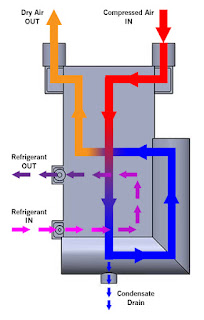With so many sizes, styles, features, and capacities of Industrial Compressed Air Dryers on the market today, it may seem difficult to figure out which one will ensure clean, dry Air for your compressed air applications. Well, the very first step is to determine which type of compressed air dryer will work for you.
Basically, there are two main types of Industrial Compressed Air Dryers - Desiccant & Refrigerated.

Desiccant Air Dryers dry compressed air by passing the air through a bed of desiccant media. As the saturated air passes through the desiccant media, the water particles adhere to the individual beads of desiccant, allowing the air to continue on in a de-saturated, dry state. After some time, the desiccant bed will, itself, become saturated and unable to hold any more moisture particles. In order to continue to dry any more incoming compressed air, the desiccant dryer will have to switch to a second desiccant bed within the air dryer. Switching to a second desiccant bed offers two main benefits:
- Allows the Air Dryer to continue drying incoming saturated air without interruption
- Provides a method of regenerating the first desiccant bed by diverting some of the newly dried air through the first desiccant bed, which carries moisture particles away from the desiccant beads and purges the moisture from the Air Dryer
The switching between desiccant beds is typically handled with a timer or dewpoint monitor, switching beds prior to either bed reaching the point of saturation. The resulting continuous dry air exits the dryer and is available for use by downstream processes.

Refrigerated Air Dryers dry compressed air by passing it through a refrigerant to compressed air heat exchanger. Saturated air enters a pre-cooler/re-heater heat exchanger and is pre-cooled by outgoing cold air. The air then enters the air to refrigerant heat exchanger and is cooled to its lowest point, causing the moisture to change from a vapor to a liquid, which is then removed from the Air Dryer through a water separator and drain valve. The cold air is then re-heated by incoming warm air as it passes back through the pre-cooler/re-heater and exits the air dryer, ready for use within the Compressed Air System.
Desiccant Air Dryers
- Outlet Dewpoints of -40°F (-40°C) to -100°F (-73°C)
- Can be used for sub-freezing applications
- Good for Point of Use
- Higher initial investment cost
- Higher operating cost
Refrigerated Air Dryers
- Outlet Dewpoints of 38°F (3.3°C)
- Use for ambient temperatures above freezing
- General manufacturing / shop air
- Lower initial investment cost
- Higher operating cost
To read the full story and use our Air Dryer Type Selector Tool, click Here.

